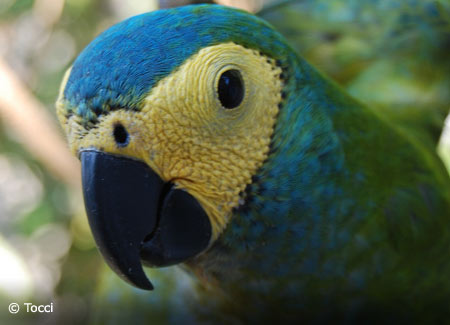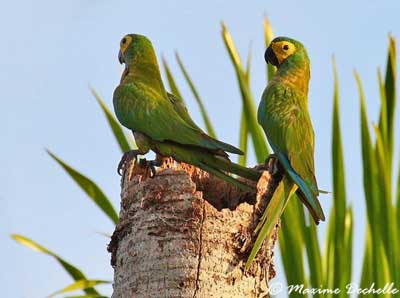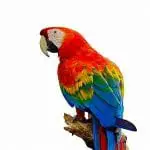Scientific Facts
| Common Name: | Red-bellied Macaw |
| Scientific Name: | Orthopsittaca manilata |
| Life Span: | Up to 40 years |
| Weight: | 300 grams |
| Length: | 18 inches |
| Habitat: | Forests, Areas with high trees |
| Country of Origin: | Amazon, South America |
Physical Description
These red-bellied macaws measure about 46 centimeters or about 46 inches, from their heads to their long tails. They also weigh about 300 grams or about 10.5 ounces. They are also very identifiable by their bare and yellow facial skins. Overall, their plumage is colored green except for the red patch in their bellies. They also have blue foreheads and upper wings, and they have a grey tint to their chin and chest. Their underwings and under tails are also colored with a dull yellow. Below their red belly patch, their lower abdomen is colored a brownish-red. Their large beaks, legs, and feet are also colored with dark grey coloring, while the irises of their eyes are dark brown.
The juvenile red-bellied macaws look a lot like the adults, except that their plumage is colored a little duller than the adults. The tails of the juvenile birds are also a little darker and shorter. The most obvious difference between a young red-bellied macaw to an old one is the color of their beaks. The juveniles have grey beaks with a horn-colored midline stripe from the top of their upper beak. This stripe disappears after they reach 1 to 2 years old.
These red-bellied macaws look a lot like the Illiger’s Macaw and the Blue-headed macaw, and some people tend to mistake them for it.
Conservation Status

The red-bellied macaws were declared as endangered by the International Union for Conservation of Nature in 2007. But, as of 2009, the species has been moved to the classification of Least Concern, mainly because their population has been boosted and is now more common in the wild compared to how it was before.
However, because these birds come with specific habitat requirements, and they face threats of habitat destruction, these birds still face the risk of extinction. Their numbers have drastically declined in areas where their nesting trees and feeding trees have been removed. Additionally, these birds are popular to take in as pets, and they can be relatively easy to catch.
Availability and Natural Habitat

Red-bellied macaws can be naturally found in Southeastern Colombia, South to Eastern Ecuador, Eastern Peru, North, Central, and Northeastern Brazil, Venezuela, Trinidad, and Northern Bolivia. They are most often seen in Mauritia palm groves, as well as swamps and forests with Aguaje or Moriche palm trees.
The red-bellied macaws heavily rely on these specific trees, as this is where they get most of their food through the fruits of these trees. They also use these palm trees for nesting in the cavities of dead ones. A large number of these parrots can also be seen at these roost sites at dawn or dusk. These birds are also mostly sedentary, and their movements are dependent on the availability of the fruits of these trees.
Behavior, Exercise, and Training
Embed Code: <iframe width=”640″ height=”360″ src=”https://www.youtube.com/embed/DQegtkMzpCs” frameborder=”0″ allow=”accelerometer; autoplay; encrypted-media; gyroscope; picture-in-picture” allowfullscreen></iframe>
Red-bellied Macaws are very smart pets, and they crave interaction. Their owners must work with them on a daily basis to sharpen themselves further and prevent these birds from throwing tantrums because they are bored. The owners can make it a point to teach them tricks of varying difficulties so that the birds have things to do. They enjoy doing simple tasks like speaking on command, answering simple questions, playing fetch, waving, or turning around. Teaching them these tricks can be much easier if the owner introduces a positive reinforcement program, like providing them with treats.
Food and Eating Habits
Embed: <iframe width=”640″ height=”360″ src=”https://www.youtube.com/embed/G0Vcay3QfJc” frameborder=”0″ allow=”accelerometer; autoplay; encrypted-media; gyroscope; picture-in-picture” allowfullscreen></iframe>
In the wild, the diet of these birds consists almost exclusively of the seeds and fruits of the moriche palm, which are 100% carbohydrate foods that are also rich in beta-carotene. When in captivity, these birds can be provided with a mixture of small seeds. The seed mix usually comprises of oats, canary, safflower, and sunflowers. They also eat sprouted mung beans, lentils, and cooked butterbeans. At times, the red-bellied macaws can also be fed lettuce, Swiss chard, sowthistle, dandelion, spinach, corn on the cob, and chickweed. Owners should also remember to emphasize on feeding them with fresh fruits and vegetables every day. If available, these birds prefer to be fed with palm fruits. These macaws also love walnuts, hazelnuts, pecans, roasted peanuts, and complete pellet food.
Breeding
Breeding red-bellied macaws is a challenging endeavor that not all keepers can accomplish. This is because these red-bellied birds have a nervous disposition, especially if they are a first-generation breed raised by wild parents. If you have birds like this, you should keep them away from noisy enclosures so they will not be startled while breeding.
The best individuals for breeding must be hand-fed, but not too tame. After they finish weaning, they must be raised in an environment with other red-bellied macaws. This will teach them social skills and allow them to be more comfortable with birds of the same species and humans.
The main challenge for breeding red-bellied macaws is their minimal bloodline. Usually, other keepers try to connect with other red-bellied macaw breeders and make breeding arrangements in order to strengthen the genetic bloodline. Doing this will also assure that red-bellied macaw keepers will be able to attain new macaws without genetic illnesses and defects.
Breeders should also be able to provide a comfortable nesting site for these birds. For best results, breeders should also consult with avian veterinarians so that standard checkups will continuously be done.
If these macaws are successful in producing eggs, the breeders can expect about two to four at a time. These eggs will be incubated for about 26 to 27 days. If everything goes well, the baby macaws will leave the next at 80 days or much sooner.
Common Health Problems
To keep track of the health of your red-bellied macaw, here are things that you can do:
- Monitor your bird’s weight, as weight loss can be a significant sign of illness, especially if the red-bellied macaw is losing weight even when they are regularly eating. Weigh them each day and watch the numbers.
- Take note of your bird’s breathing. Respiratory illnesses are also quite common in birds. It can also be a sign of bacterial infection.
- Birds may sometimes drool when they are eating and talking. But, if you can see unusual and excessive amounts of saliva, this can be a sign of something wrong.
- Observe the color of your bird and the texture of their feathers. A sick bird might have a duller color throughout their body, and their feathers might look a little ruffled. Feather plucking is also a sign of illness, so you should check for bald patches in the skin of your pet.
- Look at your bird’s eyes. A sick red-bellied macaw’s eyes will be sunken in, including a duller color.
- Watch out from unusual discharge from their eyes and their nose.
- Observe your pet’s beak because it might mean a yeast infection or other viral infections.
Environment and Housing
For their housing needs, red-bellied macaws must be placed in an aviary or a suspended enclosure. The minimum length must be about 4 meters or 13.1 feet with access to flying for the rest of the year. When selecting a cage, any owner must consider one that is powder coated or made of stainless steel. This will ensure that the red-bellied macaw will not be exposed to zinc,which is highly poisonous for these birds. If the cage they live in has any rust, it must immediately be scrubbed and then painted over with non-toxic paint.
Also, because these macaws are smaller than the others, the keepers must also watch out for bar spacing in the cage. They should not be too wide as this can cause many problems like escaping. This is especially because the birds are inquisitive and very curious, so their heads might get stuck between bars.
The bottom of the cage should also have a grill and tray to make sure that all waste falls towards the bottom, and the bird will not be able to access it. Having a tray is also much easier to slide out and clean daily.
Perches made of high-quality wood must also be installed, as these birds have strong beaks. If you can, you should also create perches of various sizes to ensure that the bird can exercise its feet.
The red-bellied macaw must also be provided with a play area. Since these birds are living in captivity, they do not get the option to forage. As foraging is an essential part of these birds’ lives, owners must invest in toys that will allow them foraging opportunities. The play area must have wooden beads, swings, and ropes to give the birds something to do throughout the day.
Fun Facts about the Red-bellied Macaw
- Red-bellied macaws are one of the most difficult types of parrots to breed in captivity because they do not have the skills to adapt to captive life conditions.
- The red-bellied macaws are not sexually dimorphic, which means that the males and the females look alike.
- In the wild, the red-bellied macaws can be seen in large flocks consisting of 10 to 20 birds per flock.
- Unlike other macaw species, the red-bellied macaws do not split from their flock mates during the breeding season. Their communities stay together the whole year.
- Red-bellied macaws are largely dependent on Mauritia palm fruits, so the loss of these plants can be a grave threat to their survival.
Where Can You Get a Pet Red-bellied Macaw?
If you want to get a red-bellied macaw as a pet, you should contact your local avian specialty store or a reputable breeder of birds in your community. Do not transact with illegal pet traders and report them if you encounter one.
How to Care for a Pet Red-bellied Macaw?
Embed: <iframe width=”640″ height=”360″ src=”https://www.youtube.com/embed/qUNbSpUBOuA” frameborder=”0″ allow=”accelerometer; autoplay; encrypted-media; gyroscope; picture-in-picture” allowfullscreen></iframe>
Because these red-bellied macaws are not commonly found in captivity, being able to take care of one is something that is truly amazing. These birds are very active, loving, and they need to interact regularly with humans for them to remain happy. It is not recommended to purchase a red-bellied macaw if you are unable to provide them the time that they need to live a stable and happy life.
These birds enjoy being petted around their eyes, behind their necks, on their chests, and sometimes on their stomachs. This type of interaction is special to these birds, as this is similar to how flock mates or other birds play with them while in the wild.
As a pet owner, it is important for a keeper to incorporate the bird’s well-being into your daily life. These birds love perching on the shoulders of their owners when their owners are reading, moving around the house, or doing household chores. These birds live for constant handling, and these make them even more tame and loving.
Red-bellied macaw owners must also be prepared for the noises that this bird can make. If you are living in an apartment, it will not do you good to keep these birds as pets because you can disrupt the peace and quiet of your neighbors. These macaws are best kept in a home environment where you do not share walls with other people. These birds usually make their calls early in the morning, at noon, and right before the sun sets.
Frequently Asked Questions
Where does a red-bellied macaw live naturally?
Red-bellied macaws reside on palm groves, swamps, and mangroves. They also forage in plantations and farmlands.
How long does a red-bellied macaw live?
Red-bellied macaws may live up to 40 years under ideal conditions.
Do red-bellied macaws make good pets?
Unlike other macaw species, red-bellied macaws need advanced care for experts who can provide ample time and resources they demand.
What tricks can I teach my red-bellied macaw?
Red-bellied macaws can learn words, phrases, and mimicking sounds in their environment. They can learn to turn around, wave, play fetch, color, and paint.
What do red-bellied macaws eat?
In the wild, red-bellied macaws love eating Mauritius palm fruits. In captivity, these birds enjoy eating seed mixes, pellets, fruits, and vegetables.



